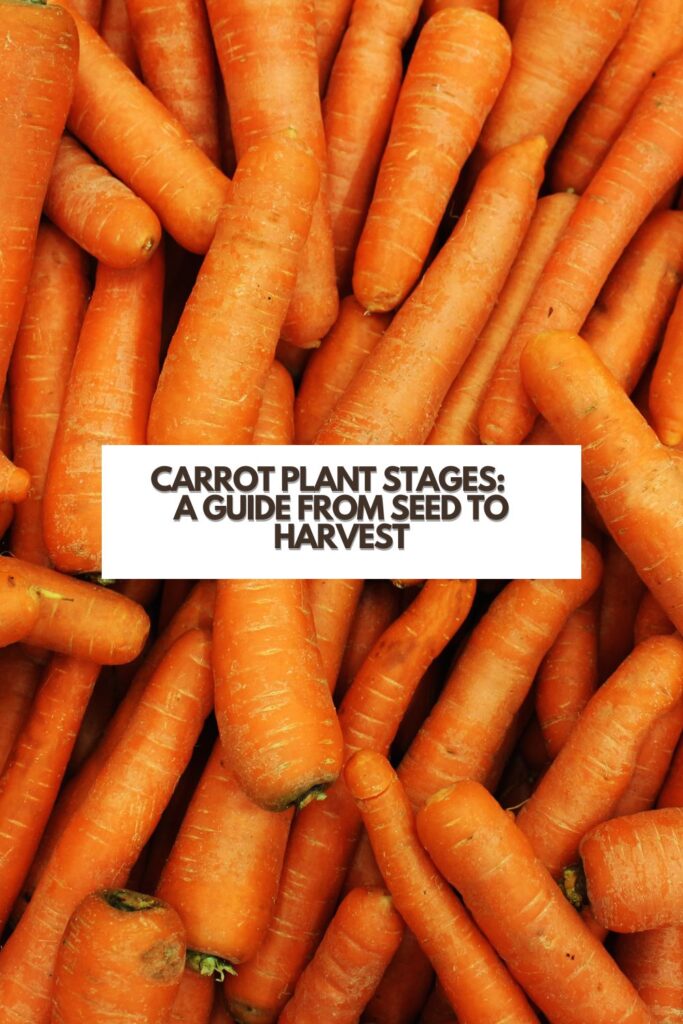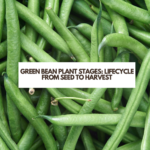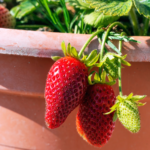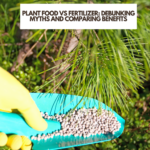Are you interested in learning more about the carrot growth stages? Carrots are a popular and nutritious root vegetable, enjoyed by people around the world for their crunchy texture and sweet taste.
Understanding the different stages of the carrot plant stages is crucial for both hobby gardeners and commercial growers to ensure a successful harvest for these root vegetables.
Knowing when to plant and how to care for carrots is important, as they thrive in certain soil and weather conditions. The ideal time for planting varies depending on the climate and carrot variety.
It is essential to track the plant’s progress through its various stages, from germination to harvesting, as this will enable growers to identify any potential issues early and address them accordingly.
FTC DISCLOSURE: Some of the links in this post are affiliate links. If you click on them and make a purchase, I will receive a small finder’s fee on the sale. This does not increase your price in any way shape or form. Using these links help support the continuation of this website. All opinions are my own. Thank you in advance.
Key Takeaways
The carrot plant life cycle consists of several stages, from germination to harvesting.
Proper planting and care are crucial for a successful carrot harvest.
Being aware of common challenges can help identify issues and ensure a healthy carrot crop.
Understanding the Carrot Plant
Carrots are biennial plants, meaning it takes two years to complete its life cycle. In its first year, the carrot plant focuses on photosynthesis and developing a strong taproot. The taproot, commonly known as the carrot itself, is responsible for absorbing water and nutrients from the soil.
We eat and harvest the carrot roots and eat them as vegetables. These are what are usually staples in one’s vegetable garden.
Carrot plants require adequate sunlight and well-drained soil to thrive. During the initial stages, the plant forms a rosette of leaves that collect sunlight to fuel photosynthesis.
This process enables the carrot to convert sunlight, water, and carbon dioxide into sugars and oxygen. The accumulated sugars are stored in the taproot, allowing the plant to grow and develop.
In the second year, the carrot plant uses the stored energy in its taproot to produce flowers and seeds. It is during this time that the plant focuses on reproduction rather than growth. As a result, the taproot usually becomes less palatable and woody. Therefore, it’s essential to harvest carrots before they enter this stage if they’re being grown for consumption.
Stages of Carrot Plant Life Cycle
Seed Stage
The life cycle of a carrot plant begins with the seed stage. Carrot seeds are typically small, flat, and oval in shape. They can remain viable in the soil for several years, but it’s best to plant fresh seeds to ensure optimal germination rates. The seeds must be sown at the right depth and spacing for ideal growth.
Germination Stage
Germination is the process by which the seed sprouts and emerges from dormancy. Carrot seed germination usually takes 2-3 weeks, depending on the temperature and moisture levels. It’s crucial to maintain consistent soil moisture throughout this stage to encourage the seeds to sprout.
Seedling Stage
Carrot seedlings: the young carrot plant starts to develop its root system and initial leaves. This process is crucial to the plant’s overall health and growth, as it establishes a strong foundation for supporting future growth.
A properly developed root system allows the plant to effectively take in water and nutrients from the soil. Seedling growth may take 4-5 weeks, during which time they should be thinned out to prevent overcrowding and encourage strong growth.
Vegetative Growth Stage
As the carrot plant enters the vegetative growth stage, it continues to develop its leaves and stems. The leaves capture sunlight and produce energy through photosynthesis, allowing the plant to grow taller and stronger.
During this stage, the carrots’ roots should also begin to elongate and store additional nutrients. This stage typically lasts for several months, and proper care, such as regular watering and weed control, is necessary for healthy growth. Make sure to give th plant good drainage and space for root growth.
Reproductive Growth Stage
At the reproductive growth stage, the carrot plant reaches maturity, and its focus shifts towards producing flowers and seeds. While most carrot plants are harvested at this point for the consumption of the roots, plants left to overwinter may enter a second season of growth.
For those interested in seed production, this is the stage where the plant becomes biennial and flowers in its second year. It’s important to note that the quality of the root often declines during this stage, making it more suitable for seed production rather than consumption.
YOU MIGHT ALSO LIKE TO READ:
Planting and Growing Carrots
Choosing the Right Variety
Several carrot varieties are available to suit different preferences and growing conditions. Gardeners can choose between early maturing and maincrop varieties. Early maturing varieties are ideal for those who wish to harvest carrots quickly, while maincrop varieties take longer to mature but produce a larger yield.
It is essential to select a carrot variety appropriate for the specific garden conditions, such as soil type and climate.
You can also opt for carrots that are made to grow in places with shorter seasons. I purchase mine from Fruition Seeds.
Preparing the Garden
Carrots thrive in well-drained, sandy soil with adequate nutrients. Gardeners should prepare garden beds or containers by loosening the soil and removing any rocks or debris. Mixing in organic matter, such as compost or well-rotted manure, can enrich the soil and improve its structure.
Additionally, incorporating a small amount of balanced fertilizer can provide essential nutrients to support carrot growth. We used this fertilizer last season with much success for root vegetables.
Sowing the Seeds
Planting carrot seeds should take place in early spring when soil temperatures reach approximately 45°F (7°C). Gardeners can sow seeds directly into garden beds or containers, spacing them about 1 inch apart and covering them with a thin layer of soil or sand.
Rows for carrots should be spaced 12 inches apart to provide adequate room for growth. Proper soil moisture is vital for germination, so it is crucial to keep the soil evenly moist but not overly saturated.
Carrot Care
Carrots require consistent care to ensure healthy growth. They should receive full sunlight, at least 6-8 hours a day, and regular watering to maintain consistent soil moisture. Overwatering can cause carrots to split, while underwatering can result in tough, fibrous roots.
Periodically checking the soil moisture and adjusting watering practices accordingly can help maintain optimal growth conditions.
Applying a light layer of mulch around the base of the carrot plants can assist in retaining soil moisture and preventing weed growth. As carrot seeds begin to germinate, it is essential to thin out the seedlings, leaving 2-3 inches between each plant.
This process ensures that each carrot has adequate spacing to develop strong roots and prevents overcrowding.
Understanding Common Challenges
Carrots can be affected by various challenges during their growth stages, including diseases and pests. This section aims to provide a clear, knowledgeable overview of common carrot diseases and the prevention and control of pests that can affect the carrot plant.
Common Carrot Diseases
Carrot plants can suffer from fungal diseases, which have the potential to affect the overall health, growth, and yield of the carrots. Some common fungal diseases include:
Alternaria leaf blight: Characterized by small, dark spots that grow into larger, yellow lesions on the leaves and stems.
Cercospora leaf spot: Presents as small, round spots with a dark center and yellow halo on the leaves.
Fusarium wilt: A soil-borne disease that causes yellowing and wilting of the leaves, followed by plant collapse.
To manage these fungal diseases, follow these recommendations:
Practice crop rotation to prevent the buildup of pathogens in the soil.
Select disease-resistant cultivars when planting carrots.
Maintain a clean and well-drained garden space, as overly wet conditions can foster fungal growth.
Preventing and Controlling Pests
Carrots can fall victim to a variety of pests that can harm their growth and diminish yields. Common pests affecting carrot plants include:
Carrot rust flies: These pests lay their eggs at the base of the plant, with larvae feeding on the carrot’s root, causing russet-colored scars on the surface.
Carrot weevils: They lay eggs on the plant’s foliage and cause damage when their larvae burrow into the carrots, creating tunnels.
To prevent and control pests in the garden, consider the following strategies:
-Use insect netting to protect carrot plants, making it difficult for pests to access them.
-Employ beneficial insects, such as predatory nematodes, to help control harmful pests.
-Monitor and remove any affected plants promptly to prevent the spread of infestations.
By understanding these common challenges, gardeners can proactively address potential issues and maintain healthy, thriving carrot plants.
Harvesting Carrots
When to Harvest Carrots
Carrots can be harvested at various stages of growth, depending on the desired size and flavor. Generally, the harvest time for carrots falls into two categories: summer harvest and fall harvest.
For a summer harvest, it is best to plant your carrots in the early spring and wait approximately 70 to 80 days for them to reach maturity. These carrots will be tender and sweet, perfect for salads and fresh eating.
A fall harvest requires planting carrots in late summer, allowing them to mature just before the first frost. These carrots will be larger and have a more robust flavor, suitable for cooking and storage. Depending on the carrot variety, the harvest time can range from 50 to 75 days.
Keep in mind that carrot tops will also reveal when it’s time for harvest. Look for the carrot shoulders (the top part of the root) to become visible at the soil surface, reaching the desired color and size.
How to Harvest Carrots
To harvest carrots, follow these simple steps to minimize damage and ensure the carrots are at their peak quality:
Check the soil moisture: Make sure the soil is moist before harvesting, as it will make the process easier. Dry soil can cause the carrots to break when pulled.
Loosen the soil: Using a garden fork or trowel, gently loosen the soil around the carrot without cutting into the root. This helps ensure the carrot can be removed without breaking or damaging the root.
Pull the carrot: Grasp the carrot greens at their base, close to the soil surface, and firmly but gently pull the carrot up and out of the ground. Do not yank or twist the greens, as this may cause the root to break.
Remove the greens: Once the carrot is harvested, cut off the greens about a half-inch above the carrot crown. This prevents moisture loss and helps preserve the carrot’s freshness.
Rinse and store: Rinse the harvested carrots in cool water to remove soil. Let them air dry and store them in a cool, dark location like a refrigerator or root cellar for maximum freshness.
Remember to harvest your carrots in a timely manner, as over-mature carrots can become woody and less palatable.
Varieties of Carrots
Nantes
Nantes carrots are a popular variety known for their sweet flavor, near-cylindrical shape, and smooth skin. They typically grow to be 6-7 inches long and have a vivid orange color. These carrots are often used as fresh produce and in recipes requiring sliced or chopped carrots.
Baby carrots are commonly derived from Nantes carrots, as they are less fibrous and have a pleasant crunch when harvested young.
Chantenay
Chantenay carrots are a compact variety, known for their broad shoulders and a conical shape that tapers down to a thick, blunt end. They range from 4-6 inches in length and have a deep orange hue with a satisfyingly crisp texture.
This carrot variety is ideal for cooking, as it holds up well when boiled or roasted, and adds a rich flavor to stews and soups.
Imperator
Imperator carrots are known for their long, tapered roots that can grow up to 10-12 inches in length. They have a darker orange color and a slender shape, with a slightly tougher skin compared to other varieties. Although they are less sweet than Nantes or Chantenay carrots, Imperators are favored for their versatility and robust nature.
They are great for both fresh consumption and cooking, retaining their structure in recipes that require extended cooking times.
Danvers
Danvers carrots are characterized by their conical, wedge-like shape, broad shoulders, and strong, fibrous texture. They usually grow 5-8 inches long and have a rich, dark orange color. Originally bred for their high yield and capacity to grow well in clay soils, Danvers carrots are often cultivated in challenging growing conditions.
They are a hardy variety known for their resistance to splitting and cracking. Due to their strong flavor and texture, they excel in recipes that require long-cooking times, such as slow-cooked dishes and soups.
Processing and Usage of Carrots
Carrots are versatile vegetables that can be enjoyed in a variety of ways. They are typically washed, peeled, and sliced, diced, or grated before usage. Fresh carrots can be eaten raw, added to salads, or used as a crunchy snack with dips like hummus or guacamole. They also add a sweet and earthy flavor to many cooked dishes.
Carrots are commonly used as ingredients in stews, soups, and stir-fries. They blend well with other vegetables, meats, and spices, providing a balanced taste and texture to any dish. Carrots can be boiled, steamed, or sautéed to be served as a side dish or added to casseroles and rice dishes.
In addition to savory dishes, carrots are also used in sweet preparations. They are frequently incorporated into baked goods such as cakes, muffins, or cookies, adding moisture and a delectable sweetness. Carrot cake, for instance, is a popular dessert often served with cream cheese frosting or a dusting of powdered sugar.
Apart from culinary uses, carrots are also well-regarded for their high nutritional content. They are rich in vitamins, minerals, and antioxidants, which provide numerous health benefits. Vitamin A, which supports eye health and immune function, is particularly abundant in carrots. The regular consumption of carrots can help maintain overall health and wellness.
In conclusion, the processing and usage of carrots are quite diverse, ranging from raw consumption to incorporation in various sweet and savory dishes. As a nutritious and versatile vegetable, carrots are an essential addition to any diet.









